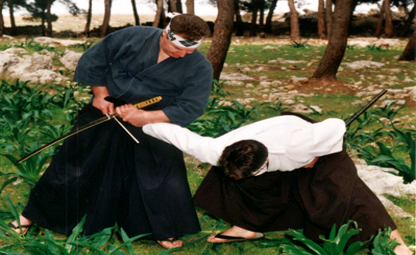
JUTTE
The Jutte (十 手) also called jitte, literally "ten hands", is
a weapon of the type baton native to medieval Japan. Composed
of an iron bar with a handle and a hilt, in the shape of a
mustache facing upwards, to protect the hand. It was used by
government officials and police during the Edo period
(1603-1868). Since in that historical period all samurai were
forbidden to carry the two swords, the police and the
shogunate officials adopted it as the main weapon to defend
themselves against a katana attack by criminals. In fact, the
blade is intercepted in the hilt and locked with rotary hand
movements.

TESSEN
The tessenjutsu (鉄 扇 術) is the martial art of the Japanese
combat fan, the card. The use of the fan in combat is
mentioned in ancient Japanese legends. For example, it is said
that Yoshitsune, the brother hero of the first shōgun
Yoritomo, defeated the fort Benkei by parrying his lance with
a tessen. This use of the text was taught to him by a
mythological creature, a tengu, who also taught him in the art
of the sword. The practitioners of tessenjutsu could acquire
great skill. Some became so skilled that they were able to
defend themselves against an attacker who wielded a sword, and
even kill an opponent with a single blow. Like many other
Japanese martial arts of that era, tessenjutsu was very
sophisticated. For example, a famous swordsman of the late
sixteenth century, Ganryu, managed to defeat many enemies with
a tessen. In addition to being used in duels against enemies
armed with swords and spears, a skilled person could use it to
deflect poisoned knives and darts thrown at him.
KODACHI
A kodachi (小太刀), literally translating into "small or short
tachi (sword)", is one of the traditionally made Japanese
swords (nihontō) used by the samurai class of feudal Japan.
Kodachi are from the early Kamakura period (1185–1333) and are
in the shape of a tachi. Kodachi are mounted in tachi style
but with a length of less than 60 cm. They are often confused
with wakizashi, due to their length and handling techniques.
However, their construction is what sets the two apart, as
kodachi are a set length while wakizashi are forged to
complement the wielder's height or the length of their katana.
As a result, the kodachi was too short to be called a sword
properly but was also too long to be considered a dagger, thus
it is widely considered a primary short sword, unlike the
Tantō or the Wakizashi which would act as a secondary weapon
that was used alongside a longer blade.
SHURIKEN
A shuriken (Japanese 手裏剣; literally: "hidden hand blade") is
a Japanese concealed weapon that was used as a hidden dagger
or metsubushi to distract or misdirect. Shuriken came in a
variety of forms; some were manufactured, while others were
improvised from tools. The edges of shuriken were often
sharpened, so they could be used to penetrate skin or open
arteries. Shuriken are commonly known in the West as throwing
stars or ninja stars although they were originally designed in
many different shapes. The major varieties of shuriken are the
bō shuriken (棒手裏剣, stick shuriken) and the hira shuriken
(平手裏剣, flat shuriken) or shaken (車剣, also read as kurumaken,
wheel shuriken). Shuriken were supplementary weapons to the
sword or various other weapons in a samurai's arsenal,
although they often had an important tactical effect in
battle.
◯ In our school, the
Daitokai, are still handed down these weapons techniques.

 大東流合気武道大東会
大東流合気武道大東会

